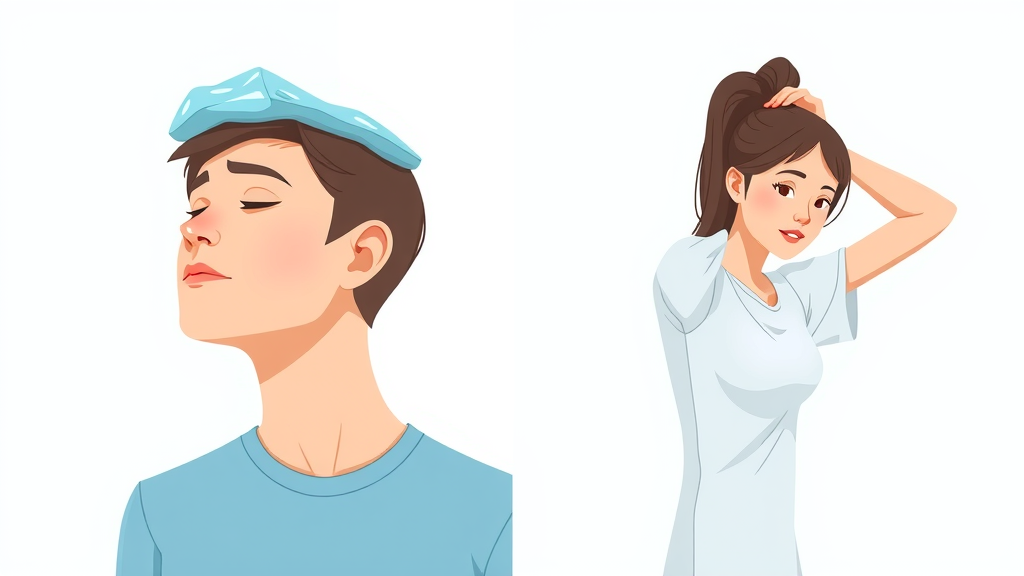Did you know that nearly 30% of adults experience neck pain every year? With demands from work, screens, and daily stress, finding reliable neck pain relief methods has never been more crucial. In this comprehensive guide, discover how to relieve neck pain quickly using proven methods. We’ll explain what really works, what doesn’t, and how to keep pain from coming back—so you can get back to life, pain-free.
Startling Facts About Neck Pain Relief Methods
A Rapidly Growing Health Concern
Neck pain is rapidly becoming one of the leading reasons adults seek health care. The rise of “tech neck” from prolonged device use, increased desk jobs, and chronic poor posture means neck pain is now a challenge for people of all ages—not just older adults. In fact, nearly 30% of adults experience neck pain every year, making effective neck pain relief methods more important than ever. This underscores the urgent need for evidence-based treatments, fast home remedies, and preventive habits that can keep neck pain and neck stiffness at bay.
"Nearly 30% of adults experience neck pain every year, making effective neck pain relief methods more important than ever."

What You'll Learn About Neck Pain Relief Methods
- The most effective neck pain relief methods and home remedies
- How to recognize when neck pain might signal a serious problem
- Physical therapy and neck exercises for quick pain relief
- Preventative strategies to reduce the risk of persistent or stiff neck
- FAQs and expert recommendations for neck pain sufferers
Understanding Neck Pain: Causes and Types
Common Causes of Neck Pain
- Poor posture
- Muscle strain
- Injury or trauma
- Degenerative diseases
- Neck stiffness and its triggers
Many people develop neck pain from day-to-day habits like sitting at a computer, slouching on a couch, or cradling a phone between the shoulder and ear. Poor posture leads to muscle strain, which stresses the neck muscles and upper back, triggering pain and stiffness. Whiplash from accidents and degenerative diseases like osteoarthritis can further contribute to chronic neck pain and persistent neck stiffness. Identifying the specific triggers—whether muscle strain, poor posture, or repetitive activities—is crucial in selecting the right neck pain relief methods.
When to Worry: Serious Symptoms
- Signs neck pain needs urgent attention
- How neck pain can cause nausea
Sometimes, neck pain signals a serious underlying issue. If you notice symptoms such as severe pain after an injury, loss of balance, limb weakness, persistent nausea, or sudden onset of headache, seek immediate care. Neck pain can also cause nausea due to nerve irritation or tension headaches. If your neck pain is accompanied by fever, numbness, tingling, or difficulty swallowing, it may indicate infections or neurological concerns—prompt medical evaluation is essential. Don’t ignore these red flags; early intervention can make a significant difference in outcomes.
Top Neck Pain Relief Methods: Immediate and Lasting Solutions
Neck Pain Relief at Home: Fast Remedies
- Hot and cold therapy for stiff neck
- Gentle stretching exercises for neck muscles
- Massage and self-massage techniques to relieve neck pain
For many, quick relief starts at home. Applying an ice pack to reduce inflammation and numb pain, or a heating pad to relax tight neck muscles, can bring significant comfort. Alternate between cold and heat for 20 minutes at a time, with a cloth between the pack and skin to prevent injury. Gentle stretching exercises improve blood flow, ease stiffness, and boost flexibility. Try slowly tilting your head side to side while maintaining good posture, or gently rolling shoulders backward to loosen upper back and neck muscles. Massage—whether by hand, with a foam roller, or from a partner—relieves tension and increases blood flow, accelerating the healing process for stiff necks.

Over-the-Counter and Prescription Pain Relievers
- How pain relievers like naproxen and ibuprofen help with neck pain relief
- When to consult with a healthcare professional
Pain relievers such as ibuprofen and naproxen can temporarily reduce neck pain, decrease neck stiffness, and help relieve pain signals, especially following minor injuries or overexertion. These medications work by reducing inflammation in the muscles and joints, enabling easier movement. However, not all cases are suitable for self-treatment. If pain is persistent, severe, or accompanied by other symptoms, consult a care provider for proper diagnosis and prescription-strength options. Prolonged use of any pain reliever—especially if you have other chronic conditions—should be overseen by a healthcare professional to avoid side effects and interactions.
Professional Neck Pain Relief Methods
- When to seek help from a physical therapist
- Role of physical activity and targeted exercises
- Chiropractic and alternative therapies
For ongoing or severe neck pain, a physical therapist can develop a customized program targeting your specific weaknesses and imbalances. Physical therapists use hands-on techniques, supervised stretching, and functional strengthening exercises for optimal recovery. Including physical activity—targeted at improving neck muscles, flexibility, and posture—is key for both pain relief and prevention of chronic pain. Alternative therapies such as chiropractic adjustments, acupuncture, or therapeutic massage may offer additional relief for certain people; always consult with your care provider before starting these routes.

Home Remedies for Neck Pain Relief
- Effective and safe home remedies
- Natural remedies vs. medications
Beyond medication, home remedies such as warm compresses, Epsom salt baths, and mindful stretching provide gentle, drug-free pain relief. Natural options like arnica gel or topical menthol can loosen muscles, while deep breathing techniques help reduce overall tension. While home remedies are great for mild strained necks, medications and medical supervision are still necessary for severe or persistent pain. The best approach is an integrated one: combine the most effective home strategies with professional guidance for sustained neck pain relief.
13 Expert Tips to Prevent Neck Pain and Stiff Neck
- Adjust your workstation for better posture
- Take frequent breaks from screens
- Use proper sleep positions and pillows
- Stay hydrated
- Incorporate neck mobility exercises
- Avoid carrying heavy bags
- Manage stress levels
- Engage in regular physical activity
- Mind your phone habits
- Warm up before exercise
- Avoid sudden neck movements
- See a specialist for persistent issues
- Track your pain and recovery patterns
Establishing healthy habits is the best way to prevent neck pain. Start with your environment: use an ergonomic chair, raise screens to eye level, and keep feet flat on the floor. Frequent movement breaks and regular physical activity keep blood flow and muscle tone high, warding off muscle strain and neck stiffness. Invest in a supportive pillow for sleep, avoid carrying purses or backpacks on one shoulder, and always warm up before physical activity. Track pain patterns and seek help early, especially for ongoing or chronic conditions. Small changes today can prevent neck pain for years to come.

Neck Pain Relief Methods for Special Populations
Neck Pain in Children: What Parents Should Know
Children can develop neck pain from poor posture, heavy backpacks, or even viral infections that cause temporary swelling. For minor pain, use a warm compress, gentle stretching, and ensure that screen time is limited. If your child experiences severe or persistent pain, fever, weakness, or any unusual symptoms, see a pediatric care provider immediately; some childhood illnesses can cause serious neck problems, and early intervention is key to rapid recovery.
Neck Pain Relief for Older Adults
Older adults are at greater risk for chronic neck pain due to degenerative changes and decreased muscle strength. Their neck muscles may weaken, leading to more frequent pain and stiffness. Gentle movements, assisted stretching, and physical therapy make a world of difference. Regular physical activity helps keep neck muscles strong, maintains flexibility, and reduces the risk of falls and associated injuries. Avoid prolonged inactivity and consider consulting a physical therapist who specializes in geriatric health for optimal results.
Managing Neck Pain During Pregnancy
Neck pain is common in pregnancy due to hormonal changes, shifting posture, and ligament laxity. Pregnant women should focus on gentle stretching, using supportive pillows, and practicing good posture both day and night. Avoid strenuous activities that strain the neck muscles and consult an obstetric care provider before starting any neck pain relief methods that involve medication or intensive therapy. Mindful relaxation techniques and safe, approved home remedies are often the best first steps.

Comparing Neck Pain Relief Methods: What Works Best and Why
| Method | Effectiveness | Speed of Relief | Cost | Recommended For |
|---|---|---|---|---|
| Home Remedies | Moderate (for mild pain) | Fast (within 24 hours) | Low | Acute/stiff neck, early symptoms |
| Medications | High (especially for inflammation) | Moderate to fast (within hours) | Low – Moderate | Moderate/severe pain, inflammatory flare-ups |
| Physical Therapy | Very High (especially for chronic pain) | Slower onset, long-term results | Moderate – High | Chronic pain, injury, postural issues |
| Alternative Treatments | Varies | Varies | Moderate – High | Adjunct to above, specialty cases |
Debunking Myths: What Doesn’t Work for Neck Pain Relief
- Commonly recommended but ineffective remedies
- Potential risks and side effects of popular treatments
Not every popular recommendation is supported by evidence. Placing an ice pack on the forehead, for example, does nothing to relieve neck pain. Heavy reliance on over-the-counter pain relievers or aggressive “cracking” can lead to side effects or worsen the problem. Avoid treatments that promise instant fixes or that involve unnecessary manipulation of the neck. The best approach combines science-backed methods, professional advice, and realistic expectations—sustainable relief comes through consistent, proper care.

Quotes From Physical Therapists on Effective Neck Pain Relief Methods
"Personalized exercise and posture correction are crucial for fast and lasting neck pain relief." – Dr. Jennifer Lee, Physical Therapist
Physical Activity and Neck Muscles: The Foundation of Pain Relief
Targeted Exercise Routines to Relieve Pain and Prevent Neck Stiffness
"Strengthening neck muscles through physical activity greatly reduces recurrence of neck pain."
- Simple at-home routines
- Safe exercises for stiff neck
Simple routines such as chin tucks, side bends, and slow, controlled rotations can ease neck stiffness and build resilience. Focus on maintaining alignment and moving within a pain-free range, pausing if pain increases. Consistency is key—performing these exercises a few times a week can dramatically reduce future neck pain episodes. If unsure, consult a physical therapist or watch certified instructional videos to ensure proper form, minimize injury, and maximize results.
Home and Lifestyle Adjustments for Sustained Neck Pain Relief
- Optimizing sleep and bedding choices
- Reducing screen time and improving posture
- Maintaining an active lifestyle
A supportive mattress and a contoured pillow can make all the difference for neck pain sufferers. Place screens at eye level and use reminder apps to encourage movement and correct posture. Limit device use whenever possible and engage in daily walks or gentle exercise to support lasting relief. Remember: healthy daily routines are your ultimate defense against tech neck and related chronic pain.
People Also Ask: Neck Pain Relief Methods FAQ
How do you get rid of neck pain asap?
- Quickest neck pain relief methods include rest, ice packs, and gentle stretching. For severe pain, consult a healthcare provider.
Why does neck pain cause nausea?
- Neck pain can lead to nausea due to nerve irritation, tension headaches, or underlying conditions. Persistent symptoms should be evaluated by a physician.
How to relieve neck pain in a child?
- Apply gentle massage, use a warm compress, and encourage stretching. Seek medical help if the pain is severe, persistent, or accompanied by other symptoms.
Is naproxen good for neck pain?
- Naproxen is an effective pain reliever for neck pain but should be used under medical guidance, especially for those with other health issues.
Frequently Asked Questions About Neck Pain Relief Methods
- What is the best neck pain relief method for chronic sufferers?
- Should I apply heat or cold for a stiff neck?
- When should I see a physical therapist?
- Can poor posture really cause neck pain?
- How to prevent neck pain recurrence?
For chronic sufferers, a blend of physical therapy, postural coaching, and regular exercise offers the most reliable results. Cold therapy is best suited for recent injuries to reduce inflammation, while heat provides relief for lingering stiffness. Consider consulting a physical therapist if pain lasts more than a week, recurs frequently, or limits daily activities. Poor posture is a leading cause of neck pain—addressing it can dramatically reduce your discomfort and risk of recurrence.
Key Takeaways: Neck Pain Relief Methods That Work Fast
- Effective neck pain relief methods include home remedies, medication, and physical therapy
- Early intervention yields the best results
- Prevention and lifestyle changes are vital components
Conclusion: Choosing the Best Neck Pain Relief Methods for You
- Select neck pain relief methods based on the cause, severity, and your medical history
- Consult a professional for persistent or severe pain
 Add Row
Add Row  Add
Add 



Write A Comment